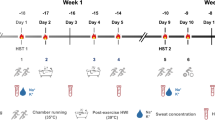Summary
Pigs were trained to perform an operant response for a reinforcement of radiant heat and comparisons were made between oxygen consumption during sessions when extra heat was available and others when it was not. It was found that as judged by the rate of oxygen consumption the efficiency with which heat was obtained was very high when the radiation was allowed to increase air temperature, but declined when air temperature remained low. If the pig had to make several responses for a single reinforcement, there was no saving in oxygen consumption. Reducing the intensity of the heating led to a reduction in the frequency at which responses were made. When the reinforcement was a brief respite from a draught, the pigs performed a greater number of responses at low ambient temperatures, but this was not accompanied by any saving in the rate of oxygen consumption.
Similar content being viewed by others
References
Baldwin, B. A., Ingram, D. L.: Behavioural thermoregulation in the pig. Physiol Behav.2, 15–21 (1967)
Baldwin, B. A., Ingram, D. L.: Factors influencing behavioural thermoregulation in pigs. Physiol. Behav.3, 409–416 (1968)
Baldwin, B. A., Lipton, J. M.: Central and peripheral temperatures and EEG changes during behavioural thermoregulation in pigs. Acta neurobiol. exp.33, 433–447 (1973)
Bligh, J.: Temperature regulation in mammals and other vertebrates, pp. 192–211. London-New York: North Holland-Elsevier 1973
Cabanac, M.: Thermoregulatory behaviour, pp. 19–36. In: Essays on temperature regulation, J. Bligh and R. E. Moore, (eds.) London-New York: North Holland 1972
Carlisle, H. J.: Heat intake and hypothalamic temperature during behavioral temperature regulation. J. comp. physiol. Psychol.61, 388–397 (1966)
Carlisle, H. J.: Effect of fixed ratio thermal reinforcementon thermoregulatory behavior. Physiol. Behav.4, 23–28 (1969)
Carlisle, H. J., Ingram, D. L.: The effects of heating and cooling the spinal cord and hypothalamus on thermoregulatory behaviour in the pig. J. Physiol. (Lond.)231, 353–364 (1973)
Corbit, J. D.: Behavioural regulation of body temperature. In: Behavioral and physiological temperature regulation, pp. 777–800, J. D. Hardy, A. P. Gagge and J. A. T. Stolwijk, (eds.). Springfield, III.: Ch. C. Thomas 1970
Ingram, D. L., Legge, K. F.: The thermoregulatory behavior of young pigs in a natural environment. Physiol. Behav.5, 981–987 (1970)
Kelly, C. F., Bond, T. E., Heitman, H.: The role of thermal radiation in animal ecology. Ecology35, 562–569 (1954)
Miller, N. E.: Behavioral and physiological techniques: rational and experimental designs for combining their use. Handbook of Physiology, Section 6, vol. 1, pp. 51–61. American Physiological Society (1967)
Mount, L. E.: The climatic physiology of the pig. London: Edw. Arnold 1968
Mount, L. E., Ingram, D. L.: The effect of ambient temperature and air movement on localized heat loss from the pig. Res. Vet. Sci.6, 84–91 (1964)
Author information
Authors and Affiliations
Rights and permissions
About this article
Cite this article
Ingram, D.L. The efficiency of operant thermoregulatory behaviour in pigs as determined from the rate of oxygen consumption. Pflugers Arch. 353, 139–149 (1975). https://doi.org/10.1007/BF00599874
Received:
Issue Date:
DOI: https://doi.org/10.1007/BF00599874




